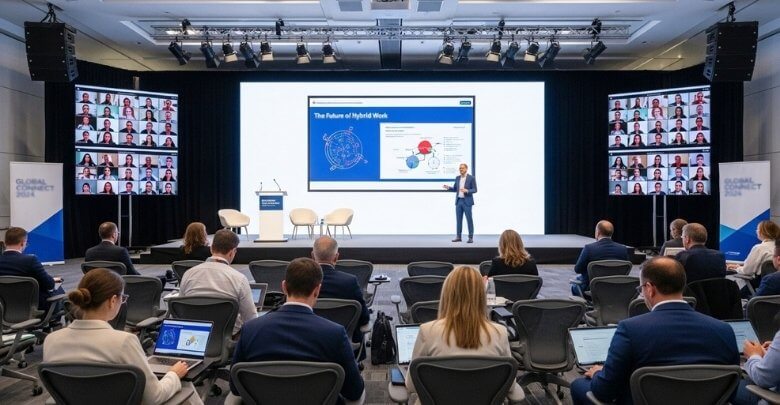These days, attending conferences is crucial because they unite people to exchange ideas, learn from one another, and form relationships. Today, many events are no longer limited to just physical venues, as hybrid conferences have created new ways to participate. Now you may ask, what is hybrid conference?
A hybrid conference is an event that brings both in-person and virtual participants together at the same time. People can either join physically at the venue or connect online using a digital platform. This format allows greater flexibility, removes travel limits, and reaches a wider audience. It also helps organizers include more people without losing the feeling of live interaction.
Are you curious to learn more about how hybrid conferences work and why they are becoming so popular? Or do you want to understand their features, challenges, and benefits in detail? Then keep reading, because this article will give you all the important information you need about the topic.
What Is Hybrid Conference?
Hybrid conferences are a modern event style that brings together both physical and virtual audiences in one setting. It gives people the freedom to join either at the actual venue or from their own space online. This model allows organizers to reach more people without being limited by location or travel needs. It also creates a flexible setup where interaction can happen smoothly between those sitting inside the hall and those attending remotely.

One of the strongest benefits of hybrid conferences is the wider reach they provide for hosts and participants. Someone unable to travel due to cost, health, or time can still join through a digital platform. At the same time, those who enjoy direct face-to-face talks can still connect at the physical location. The mix of both formats helps balance convenience and personal interaction without leaving anyone out of the experience.
Many global events are now planned in this style because of the clear advantages it brings. Even large business gatherings like conferences in Canada, the USA, and the UK have adapted hybrid formats to connect international participants with local attendees. Companies, schools, and organizations now see this model as cost-effective and inclusive for different groups of people. The following are some key features of hybrid conferences:
- Live Streaming: High-quality live streaming lets remote participants watch sessions in real time and feel included. It removes barriers and makes access simple.
- Interactive Q&A: Organizers allow live questions from both in-person and online audiences. This encourages open discussion and creates equal chances to participate.
- Digital Networking: Online platforms provide chatrooms, breakout sessions, and group discussions. These digital tools help participants connect and build meaningful professional relationships.
- Recording Options: Recorded sessions allow people to rewatch later if they missed live events. This is helpful for global audiences in different time zones.
- Polling Tools: Real-time polls let organizers collect quick feedback from participants. This adds an interactive element and makes sessions more engaging for everyone.
- Event Apps: Dedicated event apps give access to schedules, speaker information, and networking options. They keep participants updated and help with easy navigation.
- Breakout Rooms: Virtual breakout rooms support small group discussions online. These spaces mirror face-to-face table talks and make sharing ideas more personal.
- Analytics and Reports: Event platforms track engagement, attendance, and feedback. Organizers use this data to improve future events and enhance audience experience.
Which Format Do Conference Attendees Prefer Most: Hybrid or Virtual?
Conferences today come in different formats, giving people options to attend in ways that suit their needs and comfort. Some choose to join online because it feels more convenient, while others enjoy being present at the physical venue. Both styles have their own benefits and challenges. To understand which format people prefer most, let’s look at some important points together.
Accessibility
Hybrid and virtual conferences both make events more accessible for people living far away or unable to travel. Virtual attendees can easily join from home without worrying about flights or hotel costs. Hybrid conferences offer both choices, so people decide what works better for them. This flexibility makes conferences open to a wider audience.
Interaction
In-person events usually allow better face-to-face conversations that feel more natural. Virtual formats depend on chat boxes, polls, or video calls for interaction. Hybrid events mix both styles, giving remote attendees some level of participation alongside in-person networking. People often value real conversations, but digital options still create useful connections.
Cost
Joining a conference online often costs less than traveling to the actual venue. Attendees save on transport, food, and accommodation. Hybrid conferences sometimes have higher ticket prices because they cover both physical and digital arrangements. Still, the cost often balances with the wider benefits offered.
Flexibility
Virtual events allow people to attend without leaving their office or home, saving time in busy schedules. Hybrid events give even more flexibility by offering both choices together. People who like personal meetings can attend in person, while others join online. This way, everyone has the freedom to pick what suits them.
Networking
Networking is usually stronger during in-person sessions, where body language and casual talks make connections easier. Virtual platforms add features like breakout rooms and digital chats to encourage interaction. Hybrid events combine both, but remote attendees may still feel slightly limited. The format someone prefers often depends on how much they value face-to-face conversations.
Experience
The overall event experience can feel different in each format. In-person conferences may feel more engaging because of direct energy from speakers and audiences. Virtual events, on the other hand, give comfort and easy access to recordings later. Hybrid events try to bring the best of both, though sometimes technical issues affect the balance.
Both formats bring value, but preferences often depend on factors like convenience, cost, and interaction. Knowing the difference between hybrid and virtual conferences makes it easier for participants to decide what truly matches their needs.
Attending Hybrid Conference: Common Challenges and Solutions
Hybrid conferences are now very popular because they allow people to join in person or online. Still, joining them often comes with a few difficulties. These challenges can affect the overall experience and sometimes leave participants feeling less connected. Let’s take a closer look at the challenges and then at how to solve them.
Common Challenges
Technical Problems
One of the biggest challenges is dealing with weak internet, poor sound, or unclear video quality. Such problems make sessions hard to follow. Many participants get frustrated when presentations freeze or connections suddenly drop. This can quickly reduce interest and focus.
Engagement Gaps
Remote attendees often feel less included compared to those inside the venue. Without the right activities, they may lose interest. The lack of direct interaction makes online participation seem less valuable. This gap creates an uneven experience between both groups.
Time Zone Trouble
Hybrid events with international audiences face issues with timing. People from different time zones may miss live sessions. This can make some participants feel left out of important discussions. Not everyone has an same chance to attend equally.
Networking Barriers
In-person attendees can easily build relationships during breaks or casual talks. Online participants, however, usually find networking more difficult. They may miss the chance for quick introductions. This creates a clear difference between virtual and physical experiences.
Platform Confusion
Some events use multiple platforms for schedules, chats, and live sessions. Switching between them can confuse participants. People may waste time trying to figure out where to go. This can affect overall participation and satisfaction.
How to Solve Them
Prepare Your Setup
Before the event, check your internet connection, update your apps, and test your microphone or camera. Keeping a backup device ready helps as well. A simple check before joining saves you from unexpected issues. This preparation makes your sessions smoother.
Stay Engaged
Use chat boxes, polls, and Q&A features to join conversations actively. Don’t be shy about asking questions or sharing views. Being involved makes you feel more connected. Engagement helps you get more value from the event.
Use Recordings
If the timing doesn’t match your schedule, watch the replay recordings later. This way, you don’t miss important sessions. Many events also provide highlights or summaries. Taking notes while watching recordings helps keep the learning fresh.
Join Networking Rooms
Take part in digital breakout rooms or networking sessions offered in the platform. Start small conversations through chat or video calls. Even short introductions can lead to meaningful connections. Networking is easier when you take the first step.
Learn the Platform
Spend a little time exploring the hybrid conference platform before sessions begin. Check where the schedule, chat, and session links are located. Familiarity helps reduce stress during the event. This way, you focus more on content than navigation.
The Future of Hybrid Conferences
Hybrid conferences are becoming more popular as they combine both in-person and online participation. They bring people together from different places in one event. This model makes it easier for more people to join. Let’s explore how these events might shape the future.
Growing Popularity
More organizations are choosing hybrid formats because they attract larger audiences. People enjoy the flexibility of choosing how they want to attend. Online attendees save money and time, while in-person attendees enjoy face-to-face connections. This mix makes hybrid events appealing to many groups.
Technology Upgrades
Technology will keep improving hybrid conferences in the coming years. Better streaming tools and stronger platforms will reduce technical problems. Features like real-time translations and closed captions will make events more inclusive. These upgrades will make participation smoother for everyone.
Cost Advantages
One of the biggest benefits of hybrid conferences is cost savings. Attendees avoid long-distance travel expenses, while organizers spend less on large venues. At the same time, companies expand their reach without heavy spending on flights or accommodation, making this format practical and sustainable.
Global Reach
Hybrid events connect people worldwide without the limits of travel. Attendees from different countries can join the same session at once. This opens doors for new business partnerships and learning opportunities. It makes conferences more diverse and widely accessible.
Networking Options
Networking is a key part of conferences, and hybrid events are expanding these opportunities. Online platforms now provide breakout rooms, chat features, and digital meetups. In-person attendees still enjoy direct talks, but online tools bridge the gap. This balance makes networking possible for everyone.
Long-term Impact
Hybrid conferences are likely to remain a standard part of future events. They match modern needs for flexibility and accessibility. People can choose the option that best fits their lifestyle. This lasting model will continue shaping global gatherings.
Helpful Tips for First-time Hybrid Conference Attendees
Stepping into a hybrid conference for the first time can feel both exciting and unfamiliar. You might wonder how to balance between the physical and online parts of the event. Simple preparation can help you feel more confident and comfortable. Let’s look at some useful tips that make the experience easier.
Arrive Early
If attending in person, reach the venue early to find your seat and get settled. For online attendees, log in a little before the session begins. This gives you time to adjust and avoid rushing. Arriving early also helps you feel calm and prepared.
Dress Comfortably
Wearing comfortable but neat clothing helps you feel confident during the event. If you are on camera, choose something simple yet professional. This balance creates a good impression without feeling overdressed. Comfort plays a big role in keeping focus.
Stay Hydrated
Conferences often have long sessions that can feel tiring. Keep a bottle of water close, whether you are at the venue or online. Staying hydrated keeps your energy levels up. Small breaks for water also refresh your mind.
Manage Your Time
Hybrid events can be packed with many sessions. Decide in advance which talks or workshops are most important to you. Don’t try to attend everything at once. A clear plan helps you enjoy the event without stress.
Take Breaks
Sitting for long hours can make you feel restless. Use short breaks to stretch, walk around, or relax your eyes. For in-person attendees, breaks are also a good chance to casually chat with others. Resting makes you more attentive during the next session.
Be Open-minded
You might meet people from different places and industries. Listening to their experiences helps you understand the pros and cons of hybrid conferences in a clearer way. These shared insights also give you fresh ideas and perspectives. So, be open-minded and you’ll have more meaningful and enjoyable experiences.
Commonly Asked Questions
By fusing virtual and in-person experiences, hybrid conferences have revolutionized how people attend events. If you’re new to this concept, you might have many questions in mind. Here are clear and simple answers to help you understand hybrid conferences better.
How Do Hybrid Conferences Differ From Traditional Events?
Traditional events usually rely only on in-person participation, while hybrid conferences combine both physical and online attendance. To understand the hybrid conference meaning, think of it as a model that joins two formats into one. This setup allows organizers to reach wider audiences without limiting attendance to those who can travel. The mix provides a flexible style that fits modern needs.
What Role Does Technology Play in Hybrid Conferences?
Technology is at the heart of every hybrid conference. Platforms handle live streaming, networking, polls, and recordings to keep participants connected. Reliable tools ensure smooth communication between online and offline attendees, making the overall event experience stronger and more interactive for everyone.
Are Hybrid Conferences Suitable for Small Events?
Yes, hybrid formats are not just for large gatherings. Smaller events like workshops or team meetings can also use this style effectively. Even with fewer participants, hybrid conferences create inclusive environments by giving people multiple ways to attend and interact.
How Do Hybrid Conferences Support Inclusivity?
Hybrid conferences allow people with health issues, financial limits, or busy schedules to join without barriers. Online participation ensures no one misses out because of distance. In-person spaces still exist for those who prefer physical interaction, creating an inclusive balance.
Can Hybrid Conferences Be Personalized for Attendees?
Yes, many platforms used in hybrid events allow participants to customize their schedules. Attendees can choose sessions that interest them most and receive reminders. Digital tools also suggest networking opportunities, making the event more personal and meaningful for each participant.
What Industries Use Hybrid Conferences Most?
Hybrid formats are popular across industries like education, healthcare, technology, and business. Universities hold hybrid lectures, companies run product launches, and healthcare providers share research globally. The style works well anywhere inclusivity and flexibility are important for connecting people.
Can Hybrid Conferences Reduce Environmental Impact?
Yes, hybrid formats reduce the need for long-distance travel. Fewer flights and less accommodation demand mean lower carbon emissions. By offering online attendance, hybrid conferences provide a more eco-friendly alternative compared to traditional, fully in-person events.
Bottom Line
Hybrid conferences have changed the way people attend events by offering both online and in-person options. They make it easier for everyone to participate without worrying about distance, cost, or travel. This flexibility has made them a preferred choice for many gatherings worldwide.
The real strength of this model lies in its ability to bring people together, no matter where they are. Attendees enjoy learning, sharing ideas, and building connections in ways that feel comfortable to them. Organizers also benefit by reaching larger audiences and creating inclusive spaces for all.
So, when someone asks what is hybrid conference, the answer is simple. It is the future of events, combining convenience with meaningful connections. This format is here to stay, and its impact will only grow stronger.








